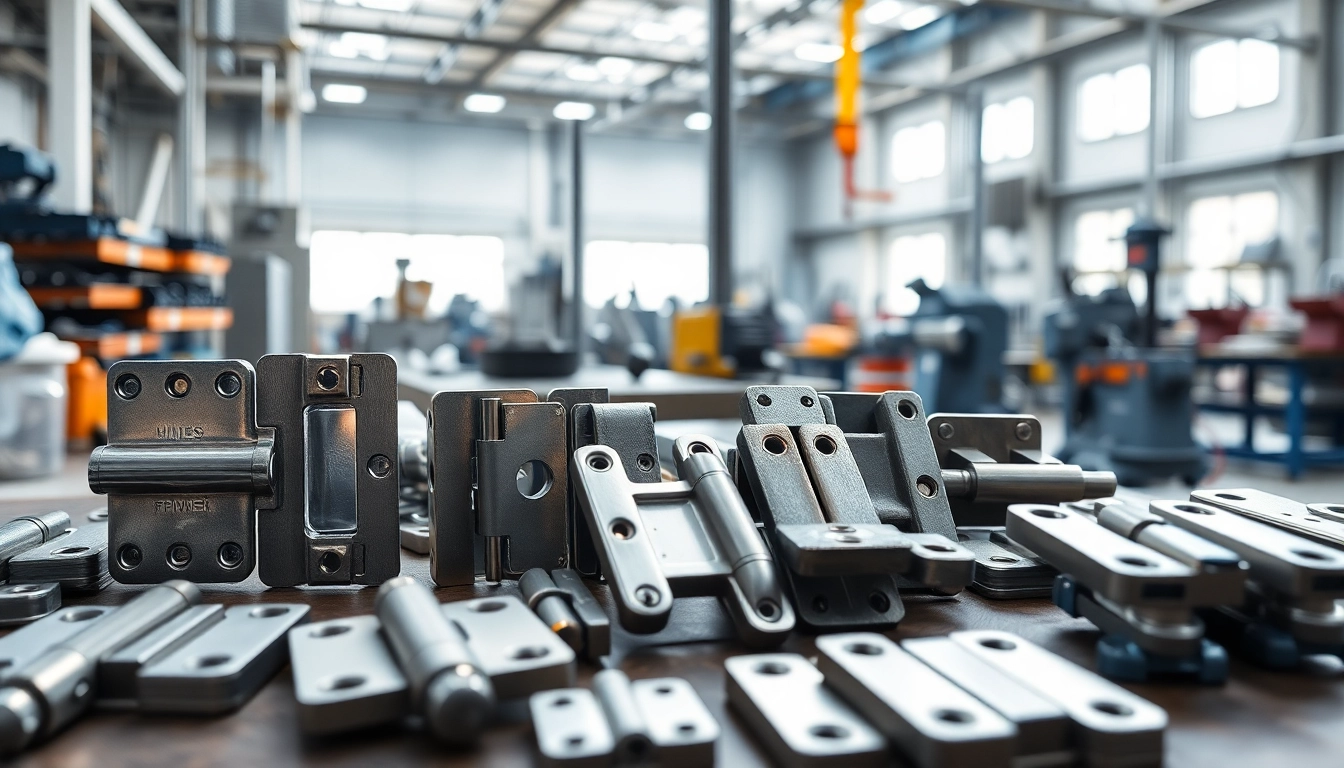
Leading Cabinet Hinge Manufacturers: Quality, Durability, and Design Innovation
Understanding Cabinet Hinges
What are Cabinet Hinges?
Cabinet hinges are a crucial element in the functionality and aesthetics of cabinetry. They are mechanical devices that attach the door of a cabinet to its frame, allowing the door to pivot open and closed. These hinges can vary in design, materials, and mechanisms, but their primary purpose remains the same: to enable smooth movement and secure closure of cabinet doors.
Types of Cabinet Hinges
When identifying which type of hinge best fits your cabinetry needs, it’s important to understand the various options available:
- Concealed Hinges: Also known as European hinges, these are hidden when the cabinet door is closed, providing a sleek and modern appearance. They allow for a clean look while offering full door access.
- Overlay Hinges: Designed for cabinets where the door covers the frame, overlay hinges are necessary when a full overlay door is used. They allow for a seamless side-by-side setup.
- Inset Hinges: These hinges are used with doors that fit inside the cabinet frame. They offer a more traditional look and require precise installation for proper function.
- Pivot Hinges: Often used in larger cabinet doors, pivot hinges allow the door to pivot from a single point, providing flexibility and style.
- Soft-Close Hinges: A modern innovation, these hinges ensure that cabinet doors close quietly and efficiently, preventing slamming and enhancing the longevity of the hinges.
The Importance of Quality Hinges
Investing in high-quality cabinet hinges is non-negotiable. Quality hinges ensure that your cabinets operate smoothly and have a long lifespan. They withstand frequent use without wearing down or failing, which is crucial in a busy kitchen or bathroom setting. Furthermore, durable hinges demand less maintenance, reducing long-term costs. For those prioritizing design and functionality, quality hinges can also complement the overall aesthetic of a room, providing the beauty of artistry along with robust performance.
Choosing the Right Cabinet Hinge Manufacturer
Key Factors to Consider
Choosing the right manufacturer for cabinet hinges involves assessing several key factors:
- Reputation: A manufacturer’s reputation is often built on the quality of its products and customer service. Research online reviews and ask for recommendations from professionals.
- Product Range: A good manufacturer should offer a wide variety of hinges to fit various styles, materials, and applications. This breadth ensures compatibility with diverse cabinetry projects.
- Customization Options: Some projects may require bespoke hinges. Manufacturers that offer customization options can meet unique specifications, further enhancing functionality and design.
- Customer Support: Effective customer service is essential for resolving issues or questions post-purchase. Look for manufacturers known for their responsive and helpful customer service.
- Warranty and Guarantees: A strong warranty or guarantee can indicate the manufacturer’s confidence in their product quality, offering peace of mind for your investment.
Top Cabinet Hinge Manufacturers Today
Several manufacturers stand out in the cabinet hinge industry due to their commitment to quality and innovation:
- Blum: renowned for their engineering excellence, Blum’s range of hinges includes soft-close options, which have revolutionized cabinet functionality.
- Grass: a trusted name in hardware, Grass offers advanced functional solutions, marrying sleek design with practical performance.
- Amerock: known for stylish designs, Amerock provides a contemporary selection of cabinet hinges that appeal to modern tastes.
- Tallsen: As a leading Cabinet Hinge Manufacturer, Tallsen focuses on quality and cost-effective solutions for a wide range of cabinetry applications.
Comparing Products and Services
Before committing to a cabinet hinge manufacturer, it is advisable to compare their product specifications, pricing, and services comprehensively. Look at the following aspects:
- Materials used: Ensure that the materials align with your durability and aesthetic goals.
- Compatibility: Verify that the hinges are compatible with your intended cabinet styles.
- Installation and support services: Some manufacturers provide additional support, such as installation guides or even customer service for assistance.
- Cost-effectiveness: Evaluate whether the price reflects the quality and longevity you expect from the product.
Material and Finish Options
Common Materials Used in Hinge Manufacturing
The materials used in hinge manufacturing significantly impact performance and durability. Common materials include:
- Steel: Often galvanized or coated, steel hinges are known for strength and durability, making them an excellent choice for heavy cabinet doors.
- Brass: Known for its classic appearance and resistance to corrosion, brass is a popular choice for decorative applications.
- Stainless Steel: An excellent option for areas where moisture is a concern, stainless steel hinges neither rust nor corrode easily, enhancing their lifespan.
- Plastic and Composite Materials: Though generally less durable, these materials can be lightweight and corrosion-resistant, making them suitable for specific applications.
Finish Options and Their Benefits
The finish of the hinge affects both its visual appeal and functionality. Common finishes include:
- Polished: Offers a shiny look perfect for traditional or upscale cabinetry.
- Brushed: Provides a more subtle aesthetic, perfect for modern interiors.
- Matte Black: A contemporary choice that can add drama and contrast in the kitchen or bathroom.
- Chrome or Nickel Plated: Useful for heightened resistance to wear, these finishes are popular in polished stainless steel setups.
The Impact of Material on Performance
The material and finish of your cabinet hinges play a critical role in their function. Heavy-duty steel hinges, for example, are essential for cabinets that will hold large items, while softer materials may suit lighter applications. The finish can also affect how well the hinges withstand regular use and environmental factors like humidity and temperature fluctuations. Thus, choosing the right combination of material and finish is essential for longevity and performance.
Installation and Maintenance Tips
Best Practices for Installing Cabinet Hinges
Proper installation is critical to ensuring that your cabinet doors function correctly. Follow these best practices:
- Read the Instructions: Most hinges come with a manufacturer’s instruction manual. Familiarize yourself with the installation process tailored to the specific hinge type.
- Use the Right Tools: Tools like a screwdriver, drill, and level are essential for accurate installation. Select a quality set to ensure precise and stable installation.
- Measure Precisely: Accurate measurement is key. Ensure that hinges are installed in the correct position for optimal function and alignment.
- Test Door Movement: After installation, test how the door opens and closes before securing everything fully. Make adjustments if necessary.
Maintaining Cabinet Hinges for Longevity
Maintenance can significantly extend the life of your cabinet hinges. Here are some tips:
- Regular Cleaning: Keep hinges free from dust and grease. A damp cloth is sufficient for a disinfection routine.
- Lubrication: Periodically lubricate hinges with silicone spray or specific lubricants to reduce friction and prevent squeaking.
- Check for Wear: Regularly inspect hinges for signs of wear and tear or rust, especially in damp environments. Addressing minor issues promptly can prevent future complications.
Common Issues and Troubleshooting
Even the best quality hinges can run into issues. Here are some common problems and solutions:
- Doors Won’t Close Properly: This can be caused by misalignment. Loosen the screws and readjust the hinge position for a better fit.
- Squeaking Noises: A lack of lubrication can lead to squeaking. Applied lubricant should resolve this issue.
- Rust on Metal Hinges: If rust appears, it may be time for cleaning or even replacing the hinge. Using stainless steel can prevent future rust issues.
The Future of Cabinet Hinge Manufacturing
Innovations in Hinge Technology
The evolution of hinge technology is paving the way for more innovative solutions for cabinetry. Smart hinges that allow for automated motion have started to emerge, enhancing usability in modern kitchens and furniture design. Companies are investing in research to improve the ergonomics and functionality of hinges, such as adjustable pivot points and soft-close features, ensuring longevity and ease of use.
Sustainability Trends in Manufacturing
As environmental concerns grow, many manufacturers are seeking sustainable practices. This includes using recycled materials and optimizing the manufacturing process to reduce waste and energy consumption. By prioritizing sustainability, manufacturers not only contribute positively to the planet but also appeal to increasingly eco-conscious consumers.
The Role of Customization in Hinge Production
In today’s cabinetry market, customization is becoming increasingly important. Manufacturers are offering more bespoke options that cater to specific design requirements, functionality, and customer preferences. This trend toward customization allows clients to choose hinges that perfectly fit their cabinetry and personal style, enhancing both the design and function.
